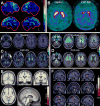Radiological biomarkers for diagnosis in PSP: Where are we and where do we need to be?
- PMID: 28500751
- PMCID: PMC5511762
- DOI: 10.1002/mds.27038
Radiological biomarkers for diagnosis in PSP: Where are we and where do we need to be?
Abstract
PSP is a pathologically defined neurodegenerative tauopathy with a variety of clinical presentations including typical Richardson's syndrome and other variant PSP syndromes. A large body of neuroimaging research has been conducted over the past two decades, with many studies proposing different structural MRI and molecular PET/SPECT biomarkers for PSP. These include measures of brainstem, cortical and striatal atrophy, diffusion weighted and diffusion tensor imaging abnormalities, [18F] fluorodeoxyglucose PET hypometabolism, reductions in striatal dopamine imaging and, most recently, PET imaging with ligands that bind to tau. Our aim was to critically evaluate the degree to which structural and molecular neuroimaging metrics fulfill criteria for diagnostic biomarkers of PSP. We queried the PubMed, Cochrane, Medline, and PSYCInfo databases for original research articles published in English over the past 20 years using postmortem diagnosis or the NINDS-SPSP criteria as the diagnostic standard from 1996 to 2016. We define a five-level theoretical construct for the utility of neuroimaging biomarkers in PSP, with level 1 representing group-level findings, level 2 representing biomarkers with demonstrable individual-level diagnostic utility, level 3 representing biomarkers for early disease, level 4 representing surrogate biomarkers of PSP pathology, and level 5 representing definitive PSP biomarkers of PSP pathology. We discuss the degree to which each of the currently available biomarkers fit into this theoretical construct, consider the role of biomarkers in the diagnosis of Richardson's syndrome, variant PSP syndromes and autopsy confirmed PSP, and emphasize current shortfalls in the field. © 2017 The Authors. Movement Disorders published by Wiley Periodicals, Inc. on behalf of International Parkinson and Movement Disorder Society.
Keywords: diagnosis; magnetic resonance imaging; positron emission tomography; progressive supranuclear palsy; single-photon emission computed tomography.
© 2017 The Authors. Movement Disorders published by Wiley Periodicals, Inc. on behalf of International Parkinson and Movement Disorder Society.
Figures


References
-
- Hauw JJ, Daniel SE, Dickson D, et al. Preliminary NINDS neuropathologic criteria for Steele-Richardson-Olszewski syndrome (progressive supranuclear palsy) Neurology. 1994;44(11):2015–2019. - PubMed
-
- Dickson DW, Hauw JJ, Agid Y, Litvan I. Neurodegeneration: The molecular pathology of dementia and movement disorders. In: Dickson D, Weller RO, editors. Progressive Supranuclear Palsy and Corticobasal Degeneration. 2nd. Chichester, UK: Wiley-Blackwell; 2011.
-
- Dickson DW, Ahmed Z, Algom AA, Tsuboi Y, Josephs KA. Neuropathology of variants of progressive supranuclear palsy. Curr Opin Neurol. 2010;23(4):394–400. - PubMed
-
- Schofield EC, Hodges JR, Macdonald V, Cordato NJ, Kril JJ, Halliday GM. Cortical atrophy differentiates Richardson's syndrome from the parkinsonian form of progressive supranuclear palsy. Mov Disord. 2011;26(2):256–263. - PubMed
-
- Litvan I, Agid Y, Calne D, et al. Clinical research criteria for the diagnosis of progressive supranuclear palsy (Steele-Richardson-Olszewski syndrome): report of the NINDS-SPSP international workshop. Neurology. 1996;47(1):1–9. - PubMed
Publication types
MeSH terms
Substances
Grants and funding
- P50 AG023501/AG/NIA NIH HHS/United States
- U01 NS086659/NS/NINDS NIH HHS/United States
- MC_U105597119/MRC_/Medical Research Council/United Kingdom
- R01 DC012519/DC/NIDCD NIH HHS/United States
- P01 AG019724/AG/NIA NIH HHS/United States
- R01 NS089757/NS/NINDS NIH HHS/United States
- T35 HL007491/HL/NHLBI NIH HHS/United States
- U01 NS082133/NS/NINDS NIH HHS/United States
- R01 AG037491/AG/NIA NIH HHS/United States
- U54 NS092089/NS/NINDS NIH HHS/United States
- R01 AG050603/AG/NIA NIH HHS/United States
- MR/M009041/1/MRC_/Medical Research Council/United Kingdom
- P50 AG005131/AG/NIA NIH HHS/United States
- MR/M024873/1/MRC_/Medical Research Council/United Kingdom
- R01 AG048234/AG/NIA NIH HHS/United States
- R01 AG038791/AG/NIA NIH HHS/United States
- WT_/Wellcome Trust/United Kingdom
- R21 NS094684/NS/NINDS NIH HHS/United States
- R01 AG045611/AG/NIA NIH HHS/United States
- MC_UU_00005/12/MRC_/Medical Research Council/United Kingdom
LinkOut - more resources
Full Text Sources
Other Literature Sources
Medical
Miscellaneous

